中国茶文化英文版完整版解读
中国茶文化英文版完整版剖析

Classification of tea
绿茶
green tea
红茶
black tea
乌龙茶
oolong tea
黄茶
yellow tea
白茶
white tea
黑茶
dark tea
? 红茶black tea
(3)Tea can prevent heatstroke
茶能降温消暑
(4)Tea drinking helps excite center and toning up the ability of doing
sport饮s 茶能刺激中枢神经,增强运动能力。
(5)there are many kinds of vitamins in the tea leaves, They are good for our health.
宁可三天无油盐,不可一日不喝茶
? Eaat rh清lyo晨mm一e杯o.r茶n,in饿g死c卖u药p家of tea, starve sell medicine
一日无茶则滞,三日无茶则病
? A day without tea is lag, the three day without tea is disease.
Chinese tea Culture
中国茶文化
Catalogue
The origin of Chinese tea Classification of tea Some famous tea in China The benefits of tea Summary
The origin of Chinese tea
Chinese-tea-culture中国茶文化英文
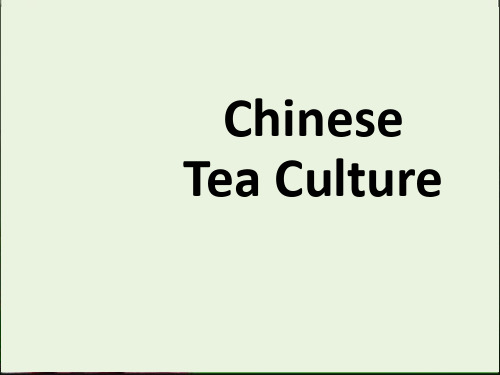
➢The use of tea was first conceived in the wild col lection activities as medical drink. But then it changed from medicinal drink into regular habit.
➢It is said that the first person to discover the effects of tea was Sheng Nong –the father of agriculture and herbal medicine in China.
TIthiesrseaisdathfatmSohuesnleNgoenngdtorife“d 7S2hedniffNeorenngtTkaisntdinsgoAf HpouinsdorneoduPs lpalnatnst”s i.nOandeadyaayn, adfhteerlwayaloknintghefogrraoulonndg, tbiamrel,ySahleivneN. Aotngthfiesltmtoirmedenatn,dhtehnirostiyc,esdosheevererastled urantdheerr afrtargereanatnldeastvaersteddroapfpirinegtofrboomiltwheatterreeinbaepsiodte. Shuimdd. eOnultyosfocmueriolesaitvyesanfedllhianbtoit,thSehepnotNfornogmpautnethaerby tlereaev.eSshinetnoNhoisnmg doruatnhkatnhdecwhaetweerdanthdefmou.nAdftietrnaotlittle ownhliyleswheefetlatnwdetlal satnyd, beuntefrrgeesthicenaginagina.sSwo ehlel.pHieckfeedlt lmesosretirleadv, essotwoeenattoanndtothdurisndkeatlol xthifeiewd ahtiesrbforodmy atnhde palol tt.he poison.
中国茶文化英文介绍(1)
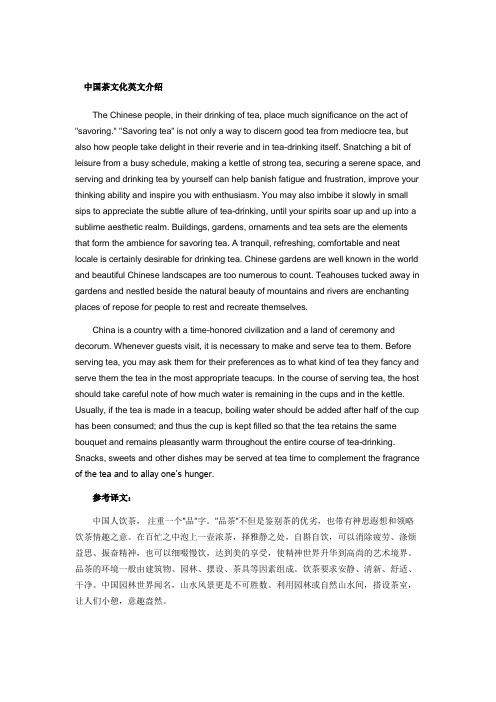
中国茶文化英文介绍The Chinese people, in their drinking of tea, place much significance on the act of "savoring." "Savoring tea" is not only a way to discern good tea from mediocre tea, but also how people take delight in their reverie and in tea-drinking itself. Snatching a bit of leisure from a busy schedule, making a kettle of strong tea, securing a serene space, and serving and drinking tea by yourself can help banish fatigue and frustration, improve your thinking ability and inspire you with enthusiasm. You may also imbibe it slowly in small sips to appreciate the subtle allure of tea-drinking, until your spirits soar up and up into a sublime aesthetic realm. Buildings, gardens, ornaments and tea sets are the elements that form the ambience for savoring tea. A tranquil, refreshing, comfortable and neat locale is certainly desirable for drinking tea. Chinese gardens are well known in the world and beautiful Chinese landscapes are too numerous to count. Teahouses tucked away in gardens and nestled beside the natural beauty of mountains and rivers are enchanting places of repose for people to rest and recreate themselves.China is a country with a time-honored civilization and a land of ceremony and decorum. Whenever guests visit, it is necessary to make and serve tea to them. Before serving tea, you may ask them for their preferences as to what kind of tea they fancy and serve them the tea in the most appropriate teacups. In the course of serving tea, the host should take careful note of how much water is remaining in the cups and in the kettle. Usually, if the tea is made in a teacup, boiling water should be added after half of the cup has been consumed; and thus the cup is kept filled so that the tea retains the same bouquet and remains pleasantly warm throughout the entire course of tea-drinking. Snacks, sweets and other dishes may be served at tea time to complement the fragrance of the tea and to allay one’s hunger.参考译文:中国人饮茶,注重一个"品"字。
Chinese-tea-culture 中国茶文化英文版
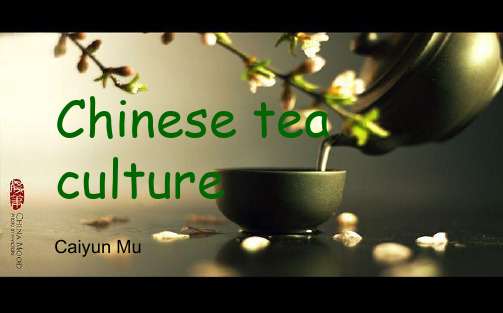
Caiyun Mu
The origin of Chinese tea
Classification of tea
Advantages and tips
Steps of making Tea
Current situation and Revival of tea culture
Classification of tea
Advantages and tips
Steps of making Tea
Current situation and Revival of tea culture
Comparison of tea consumption
per capita consumption 3500 3000 2500 2000 1500 1000 500 0
Tea—genteel Coffee- fast paced
We need Tea education
Perhaps we do not need too many schools of tea ceremony, but we just need more courses or unions in schools or universities.
Gongfu black,Qi men black,Dianhong gongfu
Tea classification
3.Dark tea(pu-er)
Features • • iron black and enveloped leaves Red , unique fragrance
for morning, refreshing ,maki ng you be waked Help lose weight, Reduce bloodpressure
英文讲解中国茶道文化
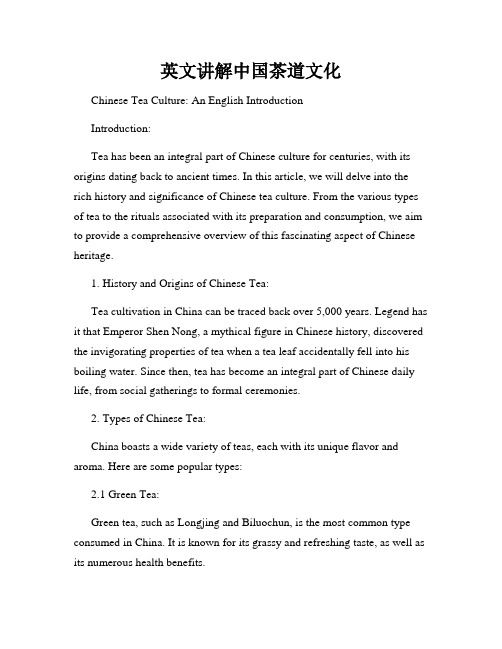
英文讲解中国茶道文化Chinese Tea Culture: An English IntroductionIntroduction:Tea has been an integral part of Chinese culture for centuries, with its origins dating back to ancient times. In this article, we will delve into the rich history and significance of Chinese tea culture. From the various types of tea to the rituals associated with its preparation and consumption, we aim to provide a comprehensive overview of this fascinating aspect of Chinese heritage.1. History and Origins of Chinese Tea:Tea cultivation in China can be traced back over 5,000 years. Legend has it that Emperor Shen Nong, a mythical figure in Chinese history, discovered the invigorating properties of tea when a tea leaf accidentally fell into his boiling water. Since then, tea has become an integral part of Chinese daily life, from social gatherings to formal ceremonies.2. Types of Chinese Tea:China boasts a wide variety of teas, each with its unique flavor and aroma. Here are some popular types:2.1 Green Tea:Green tea, such as Longjing and Biluochun, is the most common type consumed in China. It is known for its grassy and refreshing taste, as well as its numerous health benefits.2.2 Black Tea:Famous varieties of black tea in China include Dianhong and Keemun. Black tea undergoes a fermentation process, resulting in a robust flavor that is often described as malty or chocolatey.2.3 Oolong Tea:Oolong tea falls between green and black tea in terms of fermentation. Renowned for its complex flavors and floral aromas, Tie Guan Yin and Da Hong Pao are examples of popular oolong teas.2.4 Pu-erh Tea:Pu-erh tea is unique to China and is highly sought after by tea connoisseurs. Made from fermented tea leaves, it develops a rich and earthy flavor over time, with some varieties aged for several decades.3. Tea Ceremony and Etiquette:Tea is not simply a beverage in Chinese culture; it is an art form and a means of fostering social connections. The tea ceremony holds great importance in Chinese traditions, emphasizing mindfulness and respect. Here are some key aspects of tea ceremony etiquette:3.1 Tea Preparation:Tea leaves are delicately chosen and rinsed with hot water to awaken their flavors. The leaves are then steeped at specific temperatures and durations, depending on the type of tea, to ensure optimal taste.3.2 Tea Utensils:Tea sets are essential for the tea ceremony, typically including a teapot, tea cups, and a tea tray. These utensils are often crafted with precision and elegance, showcasing the appreciation for aesthetics in Chinese culture.3.3 Tea Appreciation:Chinese tea ceremonies focus on savoring the tea's aroma, flavor, and color. Participants engage in quiet contemplation as they sip the tea, appreciating its nuances and discussing its qualities. This practice encourages mindfulness and fosters connections among tea lovers.4. Health Benefits of Chinese Tea:Beyond its cultural significance, Chinese tea offers various health benefits. Due to the high concentration of antioxidants, regularly consuming tea has been associated with improving digestion, reducing the risk of cardiovascular diseases, and even helping with weight management.Conclusion:Chinese tea culture, with its long-standing history and profound traditions, offers a unique perspective on the art of tea appreciation. The diverse range of teas, elaborate ceremonies, and health benefits make Chinese tea culture a captivating and enriching experience for tea enthusiasts worldwide. Whether one seeks tranquility or a deeper understanding of Chinese heritage, exploring the world of Chinese tea is indeed a journey worth undertaking.。
中国茶文化-英语

Chinese tea culture(中国茶文化-英文版)The Chinese people, in their drinking of tea, place much significance on the act of "savoring." "Savoring tea" is not only a way to discern (识别,辨别)good tea from mediocre (普通的,平凡的)tea, but also how people take delight in their reverie(沉思)and in tea-drinking itself. Snatching a bit of leisure from a busy schedule, making a kettle of strong tea, securing a serene (平静的,安详的)space, and serving and drinking tea by yourself can help banish fatigue and frustration, improve your thinking ability and inspire you with enthusiasm. You may also imbibe(啜)it slowly in small sips to appreciate the subtle allure of tea-drinking, until your spirits soar up and up into a sublime(超群的)aesthetic(美的,美学的)realm(领域). Buildings, gardens, ornaments and tea sets are the elements that form the ambience (气氛,周围环境)for savoring tea. A tranquil, refreshing, comfortable and neat locale is certainly desirable for drinking tea. Chinese gardens are well known in the world and beautiful Chinese landscapes are too numerous to count. Teahouses tucked away in gardens and nestled beside the natural beauty of mountains and rivers are enchanting places of repose for people to rest and recreate themselves.China is a country with a time-honored civilization and a land of ceremony and decorum. Whenever guests visit, it is necessary to make and serve tea to them. Before serving tea, you may ask them for their preferences as to what kind of tea they fancy and serve them the tea in the most appropriate teacups. In the course of serving tea, the host should take careful note of how much water is remaining in the cups and in the kettle. Usually, if the tea is made in a teacup, boiling water should be added after half of the cup has been consumed; and thus the cup is kept filled so that the tea retains the same bouquet and remains pleasantly warm throughout the entire course of tea-drinking. Snacks, sweets and other dishes may be served at tea time to complement the fragrance of the tea and to allay one‘s hunger中国人饮茶,注重一个“品”字。
中国茶文化英文版PPT

1998 China International Tea Cultural Exchange Center established peace. 1998年中国国际和平茶文化交流馆建成。 With the emergence of tea culture, tea houses around more to do more. 随着茶文化的兴起,各地茶艺馆越办越多。 International Tea Culture Seminar has been opened to the fifth sector, has attracted Japanese, Korean, United States, Hong Kong and Taiwan have joined.国际茶文化研讨会已开到第五界,吸引了日、韩、美及港台地区纷纷参加。 Main producing provinces and cities and counties were organized tea “tea Festival”, such as Fujian Wuyi Rock Tea Festival City, Yunnan Pu„er tea festival, Zhejiang Xinchang, Taishun, Hubei British Hill, Xinyang tea festival too numerous to mention.各省各市及主产茶县份份主办“茶叶节”,
红茶black tea
中国茶文化的英文介绍
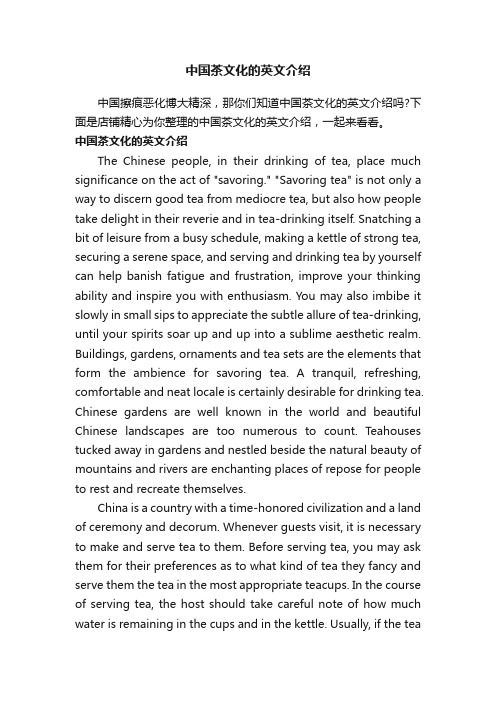
中国茶文化的英文介绍中国擦痕恶化博大精深,那你们知道中国茶文化的英文介绍吗?下面是店铺精心为你整理的中国茶文化的英文介绍,一起来看看。
中国茶文化的英文介绍The Chinese people, in their drinking of tea, place much significance on the act of "savoring." "Savoring tea" is not only a way to discern good tea from mediocre tea, but also how people take delight in their reverie and in tea-drinking itself. Snatching a bit of leisure from a busy schedule, making a kettle of strong tea, securing a serene space, and serving and drinking tea by yourself can help banish fatigue and frustration, improve your thinking ability and inspire you with enthusiasm. You may also imbibe it slowly in small sips to appreciate the subtle allure of tea-drinking, until your spirits soar up and up into a sublime aesthetic realm. Buildings, gardens, ornaments and tea sets are the elements that form the ambience for savoring tea. A tranquil, refreshing, comfortable and neat locale is certainly desirable for drinking tea. Chinese gardens are well known in the world and beautiful Chinese landscapes are too numerous to count. T eahouses tucked away in gardens and nestled beside the natural beauty of mountains and rivers are enchanting places of repose for people to rest and recreate themselves.China is a country with a time-honored civilization and a land of ceremony and decorum. Whenever guests visit, it is necessary to make and serve tea to them. Before serving tea, you may ask them for their preferences as to what kind of tea they fancy and serve them the tea in the most appropriate teacups. In the course of serving tea, the host should take careful note of how much water is remaining in the cups and in the kettle. Usually, if the teais made in a teacup, boiling water should be added after half of the cup has been consumed; and thus the cup is kept filled so that the tea retains the same bouquet and remains pleasantly warm throughout the entire course of tea-drinking. Snacks, sweets and other dishes may be served at tea time to complement the fragrance of the tea and to allay one's hunger.中国人饮茶,注重一个"品"字。
超实用中国传统文化之茶文化英文介绍

The origin of Chinese tea
the Type of Tea
green tea
black tea
processing:Fresh tea leaves -Withered -Rolled- Fully fermented- Dried
feature:red soup, red leaves,sweet, mellow, reduce the incorporation of cholesterol into mixed micelles
青瓷茶具Celadon
黑瓷茶具Black Porcelain
Lacquer tea sets
Vitreous tea sets
Making Tea
- Intorduction about Making Tea
- How to make tea
Custom of Tea
China is a country with a time-honored civilization and a land of ceremony and decorum. Whenever guests visit, it is necessary to make and serve tea to them.
Tea was discovered by ShenNong and become popular as a drink in the state of Lu —The Classic of Tea “茶之为饮,发乎神农氏,闻于鲁周公。” —《茶经》
中国茶文化介绍英文版-课件 (一)
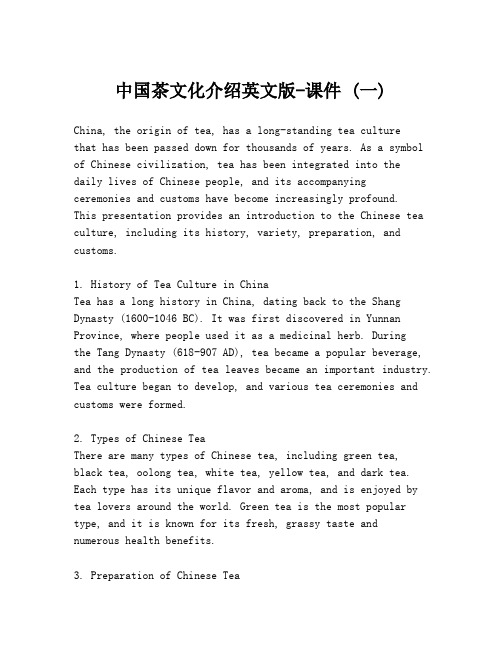
中国茶文化介绍英文版-课件 (一)China, the origin of tea, has a long-standing tea culturethat has been passed down for thousands of years. As a symbol of Chinese civilization, tea has been integrated into thedaily lives of Chinese people, and its accompanyingceremonies and customs have become increasingly profound.This presentation provides an introduction to the Chinese tea culture, including its history, variety, preparation, and customs.1. History of Tea Culture in ChinaTea has a long history in China, dating back to the Shang Dynasty (1600-1046 BC). It was first discovered in Yunnan Province, where people used it as a medicinal herb. Duringthe Tang Dynasty (618-907 AD), tea became a popular beverage, and the production of tea leaves became an important industry. Tea culture began to develop, and various tea ceremonies and customs were formed.2. Types of Chinese TeaThere are many types of Chinese tea, including green tea,black tea, oolong tea, white tea, yellow tea, and dark tea. Each type has its unique flavor and aroma, and is enjoyed by tea lovers around the world. Green tea is the most popular type, and it is known for its fresh, grassy taste and numerous health benefits.3. Preparation of Chinese TeaThe preparation of Chinese tea is an art form in itself. The water temperature, brewing time, and tea leaf quality all play a role in the flavor and aroma of the tea. Generally, Chinese tea is brewed in small teapots or cups, with the leaves steeped in hot water multiple times. This allows for the flavor and aroma to unfold and intensify with each subsequent infusion.4. Customs of Chinese TeaChinese tea is not only a beverage, but also an important part of Chinese culture. The etiquette surrounding tea drinking is very important, and serves as a means of communication and social interaction. Tea ceremonies, such as the Gongfu tea ceremony, have been performed for centuries, and are enjoyed by tea lovers around the world. Additionally, tea has been integrated into Chinese traditional medicine, and is believed to have many health benefits for the body and mind.In conclusion, Chinese tea culture is an integral part of Chinese civilization, and has been passed down for thousands of years. Its numerous varieties, preparation methods, and customs make it a unique and important art form. As people around the world continue to discover the joys and benefits of tea, the tea culture of China will continue to thrive and grow.。
中国茶文化英文版

During the tea ceremony, guests are served the tea in small cups, which are held around the tea table Guests are expected to recommend the tea, its aroma, taste, and appearance, while also engaging in political conversation with their hosts
Chinese tea culture has also become a unique part of global culture, with many tea houses and tea culture centers opening in differபைடு நூலகம்nt parts of the world
The Flavor and Aroma of Chinese Tea
• Chinese tea has a rich and diverse flavor profile that ranges from light and floral to rich and malty The flag and arc of Chinese tea vary depending on the type of tea leaves used, the brewing method employed, and the water quality
Chinese-tea-culture 中国茶文化英文版
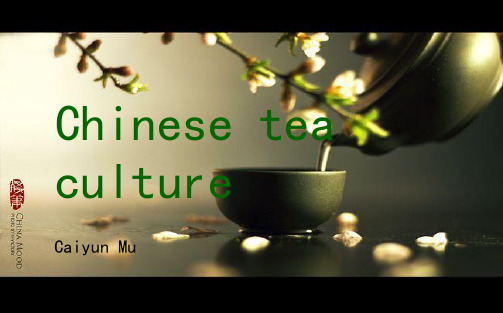
2.Black tea
• Make bones stronger • Good for your heart • Warm the stomach
second largest kind of tea
Features Fermented tea(发酵茶) red tea water, red leaves, sugariness retains its flavour for several years accounts for over 90% of all tea sold in
•clearing away summer-heat •refresh oneself and Whiten your skin
Xin Yang Mao Jian Biluochun Longjing
Huangshan Maofeng Lushan Yunwu
精品课件
Tea classification
In the meanwhile, we need more literatures about Chinese tea culture.
精品课件
Revival of tea culture
✓ Some modern teahouse ✓ Enjoy tea with friends
✓ Knack of tea-brewing and tea ceremony
✓ Tea drinking is of great benefit to prevent dental caries
✓has a good weight loss and beauty effect ✓ prevent senile cataracts. ✓ protect the hematopoiesis function ✓ Drinking tea can cooling in summerAt night ,appropriate to
中国茶文化英文版PPT完整版

Classification of tea
green tea
black tea oolong tea
yellow tea white tea black tea
black tea
green tea
yellow tea
white tea
The benefits of the tea
(1)Tea can enhance the thinking and memory abilities.
China is the homeland of tea which has beco me the national drink. Referring to Chinese tea culture, it has several thousand years of histor y and can be traced back to the ancient times. Then it was flourished in the Tang dynasty and the Song dynasty..
(2)Tea has a good effect of losing weight and beauty (3)Tea can prevent heatstroke (4)there are many kinds of vitamins in the tea leaves, They are good for our health.
We can say, the events of tea in other countries in the world, directly or indirectly, are basically spread out from China. China is the homeland of tea, and tea have become the national drink.
给外国人介绍中国传统茶文化英语作文

给外国人介绍中国传统茶文化英语作文(中英文版)Title: An Introduction to Traditional Chinese Tea CultureIn the vast and diverse tapestry of Chinese culture, tea holds a position of unique significance.It is not merely a beverage, but rather a symbol of tranquility, respect, and refined taste.The art of tea-making and appreciation is a practice that has been cultivated over thousands of years, reflecting the philosophical and aesthetic values deeply rooted in Chinese heritage.标题:介绍中国传统茶文化在中国丰富多样的文化长河中,茶文化占据着独特的地位。
它不仅仅是一种饮品,更是宁静、尊重和雅致的象征。
制茶与品茶的艺术是经过数千年沉淀的精粹,体现了深深植根于中国传统的哲学和审美价值观。
The origins of tea can be traced back to the ancient times in China, where it was not only consumed for its delightful taste and health benefits but also used in traditional medicine.The Chinese people"s love for tea has given rise to a sophisticated tea culture, which encompasses a wide array of ceremonies, customs, and etiquette that are as intricate as the flavors of the tea itself.茶的起源可追溯到中国古代,那时人们不仅因其美妙的味道和健康益处而饮用,还将其用于传统医药。
中国的茶文化英文介绍
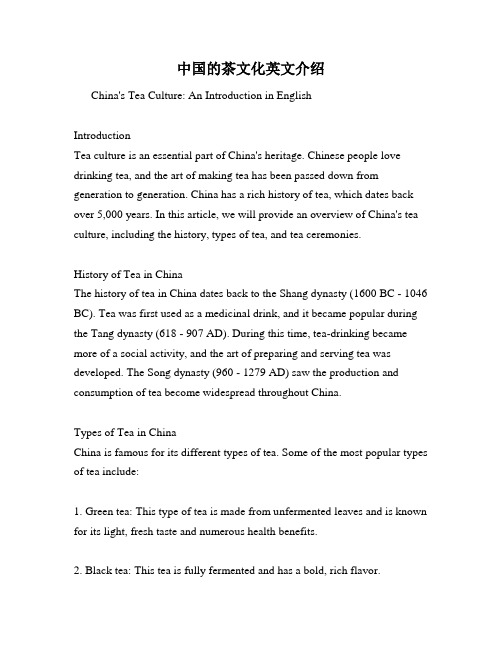
中国的茶文化英文介绍China's Tea Culture: An Introduction in EnglishIntroductionTea culture is an essential part of China's heritage. Chinese people love drinking tea, and the art of making tea has been passed down from generation to generation. China has a rich history of tea, which dates back over 5,000 years. In this article, we will provide an overview of China's tea culture, including the history, types of tea, and tea ceremonies.History of Tea in ChinaThe history of tea in China dates back to the Shang dynasty (1600 BC - 1046 BC). Tea was first used as a medicinal drink, and it became popular during the Tang dynasty (618 - 907 AD). During this time, tea-drinking became more of a social activity, and the art of preparing and serving tea was developed. The Song dynasty (960 - 1279 AD) saw the production and consumption of tea become widespread throughout China.Types of Tea in ChinaChina is famous for its different types of tea. Some of the most popular types of tea include:1. Green tea: This type of tea is made from unfermented leaves and is known for its light, fresh taste and numerous health benefits.2. Black tea: This tea is fully fermented and has a bold, rich flavor.3. Oolong tea: This tea is partially fermented, giving it a unique flavor that is not as strong as black tea and not as delicate as green tea.4. White tea: This delicate tea is made from young leaves and buds, which are picked in early spring.5. Pu-erh tea: This is a fermented tea that has a unique flavor and aroma. It is often aged for many years, and some types can be as old as 50 years.Tea Ceremonies in ChinaTea ceremonies are an important part of China's tea culture. These ceremonies have been developed over centuries, and they differ depending on the region and the type of tea being served. A tea ceremony typically involves several steps, including washing the teapot, warming the cups, and steeping the tea. The ceremony is often accompanied by poetry, calligraphy, or even music. The purpose of the tea ceremony is to create a special experience for the guests, where they can relax, enjoy the tea, and appreciate the beauty of the surroundings.ConclusionChina's tea culture is an essential part of Chinese life. It has a rich history, which has been passed down from generation to generation. Chinese people love drinking tea, and it has become an essential part of their social life. China has many different types of tea, each with its unique flavor and aroma. Lastly, the tea ceremony is an essential part of China's tea culture, and it is an experience that is not to be missed.。
茶文化英文版知识讲稿

Shen Nong Shi, the God of Agriculture, was believed to be the first to discover tea. In his “Book of Herbs”(神农本草经), it says that “Shen Nong shi personally tasted hundreds of species of herbs and he was hit by 72 poisons in a single day. But he used a kind of tree leaves to ease his case and it turned out to be tea tree."
砖茶?huazhuan花砖茶flowerbrick?heizhuan黑砖茶blackbrick?mizhuan米砖茶ricebrick?qingzhuan青砖茶greenbrick?tuocha沱茶?xiaguantuocha下关沱茶?puertuocha普洱沱茶?sichuantuocha四川沱茶huazhuanamp
Biluochun Tea
